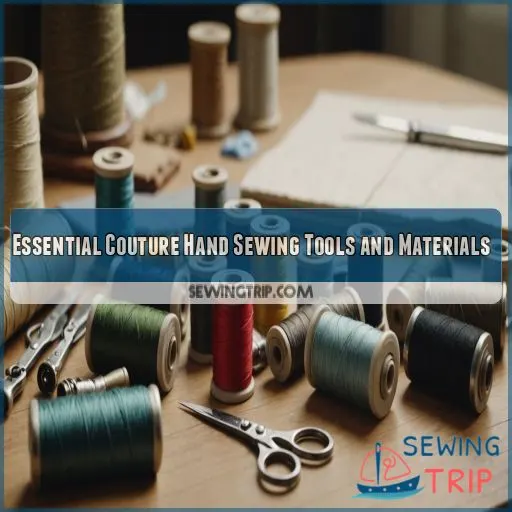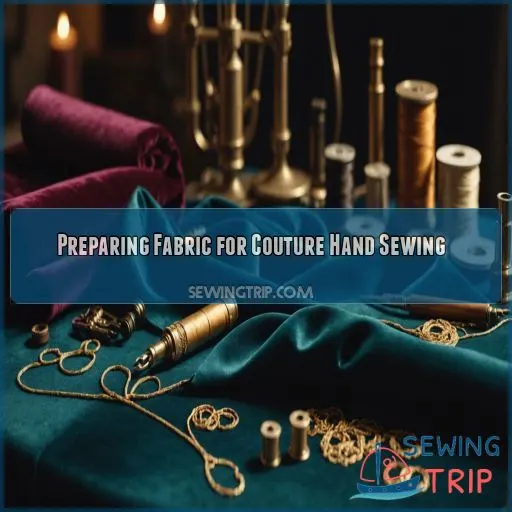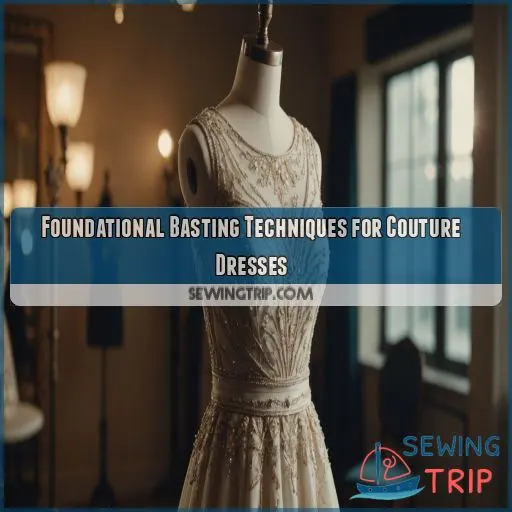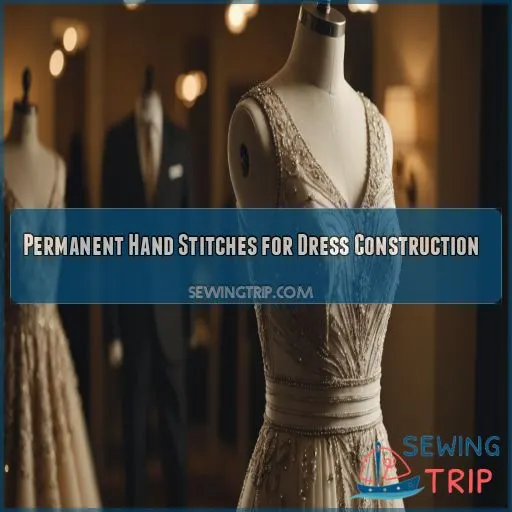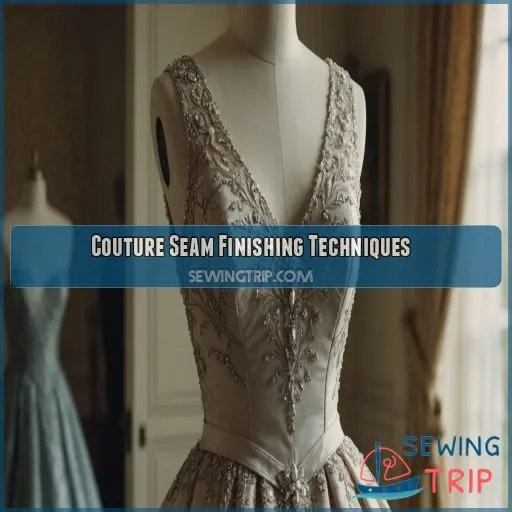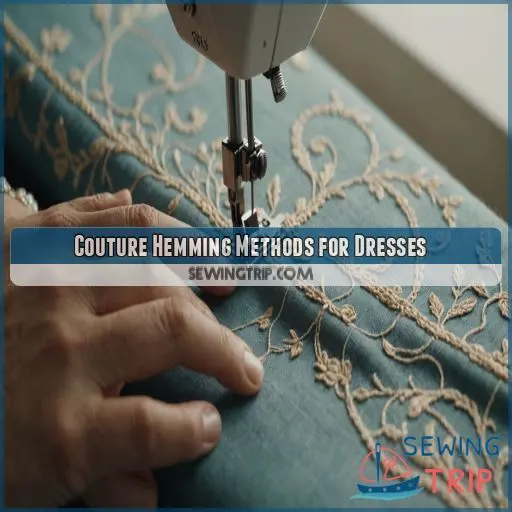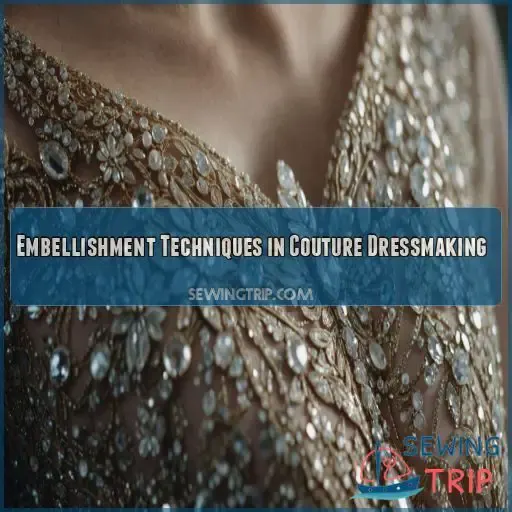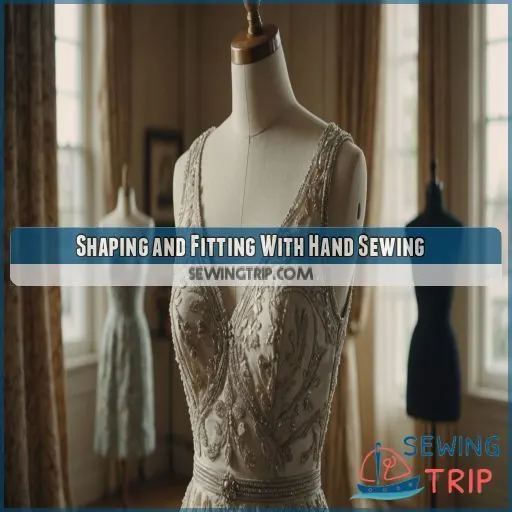This site is supported by our readers. We may earn a commission, at no cost to you, if you purchase through links.
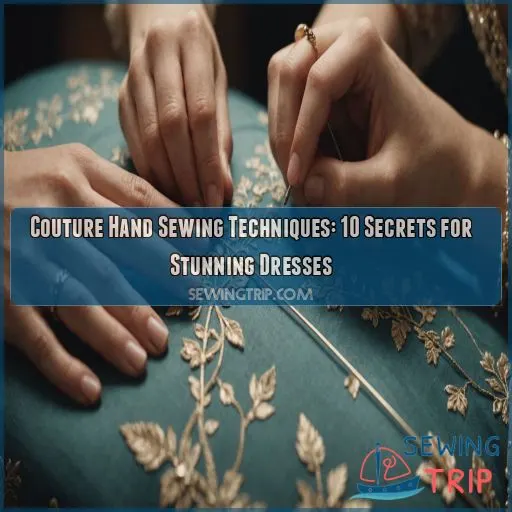
Start by mastering essential stitches like the slip basting for perfect pattern matching and the fell stitch for flawless seam finishes.
Elevate your hems with the nearly invisible blind hem stitch, and add structure with horsehair braid.
Don’t forget the details – hand-picked zippers and custom buttonholes will set your creations apart.
You’ll need patience and precision, but the results are worth it.
And who knows? You might discover a hidden talent for hand-beading that’ll have everyone asking, "Where’d you get that?
Table Of Contents
- Key Takeaways
- Essential Couture Hand Sewing Tools and Materials
- Preparing Fabric for Couture Hand Sewing
- Foundational Basting Techniques for Couture Dresses
- Permanent Hand Stitches for Dress Construction
- Couture Seam Finishing Techniques
- Hand-Sewn Closures and Fastenings
- Couture Hemming Methods for Dresses
- Embellishment Techniques in Couture Dressmaking
- Shaping and Fitting With Hand Sewing
- Advanced Couture Techniques for Dress Details
- Frequently Asked Questions (FAQs)
- Conclusion
Key Takeaways
- You’ll transform ordinary dresses into wearable art with techniques like slip basting and fell stitches. It’s like giving your fabric a magic makeover – suddenly, those pattern matches are perfect and your seams are flawless.
- Your toolkit is your fashion sidekick. From fine needles to luxurious threads, and that magical beeswax that’ll make your stitches sing, you’re arming yourself with the secret weapons of couture. Think of it as assembling your own superhero utility belt, but for fashion.
- Mastering invisible finishes like the blind hem stitch is your ticket to couture stardom. You’ll feel like a magician, creating hems that seem to disappear into thin air. Who needs smoke and mirrors when you’ve got a needle and thread?
- Don’t shy away from embellishments – they’re the icing on your couture cake. Whether you’re adding sparkle with hand-beading or crafting delicate fabric flowers, these techniques will turn your dress from "nice" to "holy cow, where did you get that?
Essential Couture Hand Sewing Tools and Materials
You’re about to start your couture journey, and your toolkit is your trusty sidekick. From precision needles to luxurious threads, and that magical beeswax that’ll make your stitches sing, we’ll explore the must-have tools that’ll transform your dress from ‘meh’ to ‘magnifique’.
High-quality Needles and Thread Selection
Ever wondered why your hand-sewn creations don’t quite match couture quality? The secret’s in your tools. For stunning dresses, you’ll need:
- Fine needles (sizes 9-11) for delicate fabrics
- Silk thread for luxurious finishes
- Polyester thread for strength and durability
- Cotton thread for natural fibers
Choose thread weight and color to match your fabric perfectly. Remember, in couture, it’s the little details that make all the difference. Your stitches will thank you!
Beeswax for Thread Strengthening
Ever wondered why couture seamstresses swear by beeswax?
It’s your secret weapon for stronger, smoother stitches.
Simply run your thread over a block of beeswax, then press it with a warm iron.
This magic trick coats the fibers, reducing tangling and fraying.
Whether you’re using silk, cotton, or polyester thread, a touch of beeswax can elevate your hand sewing from amateur to artisan.
Fabric Marking Tools and Pins
For couture sewing, precision is your secret weapon.
You’ll want to arm yourself with a variety of fabric marking tools and pins that’ll make you feel like a true garment artist.
From trusty tailor’s chalk to nifty tracing wheels, these tools are your ticket to pinpoint accuracy.
Don’t forget those glass-head pins – they’re a couture sewist’s best friend for perfect pin placement without leaving a mark!
Scissors and Cutting Implements
Now that you’ve got your fabric markers sorted, let’s sharpen our focus on cutting tools. Your scissors are like your trusty sidekick in the couture world. You’ll want to build a cutting arsenal that’ll make you feel like a fabric-slicing ninja:
- Fabric shears for precise, long cuts
- Embroidery scissors for snipping threads
- Pinking shears for reducing fraying
- Rotary cutter for straight lines and curves
Thimbles and Needle Threaders
Now that you’ve got your cutting tools sorted, let’s talk about protecting your digits and saving your sanity. Thimbles and needle threaders are your new best friends in the couture world. These little helpers will keep your fingers happy and your threads in line. Check out this handy guide to find your perfect match:
| Thimble Type | Best For | Care Tip |
|---|---|---|
| Metal | Heavy fabrics | Polish regularly |
| Leather | Delicate work | Condition with oil |
| Silicone | Beginners | Wash with soap |
| Vintage | Collectors | Store in a dry place |
Preparing Fabric for Couture Hand Sewing
You’re about to get started on a journey into couture hand sewing, where every stitch is a work of art. Before you pick up that needle, let’s explore the important steps of preparing your fabric – it’s the foundation that’ll make your dress truly stunning.
Fabric Preparation and Pre-washing Techniques
Before you get started on your couture creation, fabric prep is your secret weapon.
Start by testing a swatch for shrinkage and color bleeding.
Pre-wash your fabric using the gentlest method possible – you don’t want any surprises after all your hard work!
Once dry, give it a good press, paying attention to the grain direction.
This step sets the stage for flawless hand-sewing and makes sure your finished dress will maintain its shape beautifully.
Marking and Cutting Precision
Now that you’ve prepped your fabric, it’s time for the nitty-gritty: marking and cutting.
This step can make or break your handmade garments, so let’s get it right!
Grab your rotary cutters, pattern weights, and cutting board – it’s showtime.
Accurate seam allowances will save you headaches later.
Trust me, your future self (and sewing machine) will thank you for the extra care now.
Understanding Grain Lines and Fabric Behavior
When you’re making clothes, understanding how fabric behaves is super important.
You’ll want to get cozy with grain lines, as they’re the compass guiding your creation.
Fabric drape, bias cuts, and grain direction all play big roles in how your dress will hang.
Don’t forget to think about fabric weight and stretch; they’re the unsung heroes of a perfectly fitted garment.
Master these, and you’ll be crafting stunning dresses like a pro!
Interfacing and Underlining Application
Now that you’ve got a handle on grain lines, let’s tackle the unsung heroes of couture: interfacing and underlining.
These fabric sidekicks can make or break your dress’s structure.
Think of them as your dress’s secret support system – like Spanx, but for fabric!
You’ll want to choose interfacing and underlining that play nice with your main fabric, applying them with precision using a running stitch or flat-fell stitch for a flawless foundation.
Foundational Basting Techniques for Couture Dresses
You’re about to learn the secrets of couture basting techniques that’ll elevate your dress-making game. These foundational methods will help you tame tricky fabrics, speed up assembly, match patterns like a pro, and guarantee your construction is spot-on accurate.
Diagonal Basting for Challenging Fabrics
Tame those tricky fabrics with diagonal basting! When you’re wrestling with velvet, silk, or dealing with gathers and pleats, this technique is your secret weapon. It’s like giving your fabric a gentle hug, keeping everything in place before you commit to permanent stitches.
Here’s why diagonal basting is a game-changer:
- Prevents fabric shifting
- Secures gathers and pleats
- Works wonders on slippery materials
Don’t let challenging fabrics intimidate you. With diagonal basting in your arsenal, you’re the boss of your garment!
Running Basting for Quick Assembly
Running basting is a quick and easy way to assemble fabric.
It’s like scribbling a rough draft before writing your masterpiece.
You’ll zip through layers, aligning seams with ease.
Keep your stitches loose and even, about 1/4 inch long.
This technique is a lifesaver when you’re racing against the clock or testing a new pattern.
It’s temporary magic that will make your final stitches sing!
Slip Basting for Pattern Matching
You’ve mastered running basting, but for matching patterns, slip basting is your secret weapon.
This technique is a game-changer for plaid fabrics and stripe alignment.
It’s like playing a puzzle game with your fabric!
Simply pin your pieces together, then use long, diagonal stitches to secure them.
You’ll have perfect pattern placement without breaking a sweat – it’s fashion magic at your fingertips!
Thread Tracing for Accurate Construction
Before you get started on your couture creation, thread tracing is your secret weapon for pinpoint accuracy. This foundational technique makes sure your masterpiece comes together flawlessly. Here’s why it’s a game-changer:
- Transfers pattern markings with precision
- Acts as a guide for intricate seams and details
- Allows for easy adjustments without damaging fabric
You’ll feel like a fashion illustrator, sketching your vision directly onto the fabric. It’s a bit like connect-the-dots, but for grown-up fashionistas!
Permanent Hand Stitches for Dress Construction
You’re about to discover the artistry of permanent hand stitches that elevate a dress from ordinary to extraordinary. These couture techniques will transform your sewing skills, giving you the power to create garments with impeccable finishes and professional-level details.
Running Stitch for Seams and Gathers
When it comes to couture, the running stitch is your secret weapon for seams and gathers. It’s like the little black dress of hand sewing – versatile and essential basic hand sewing stitches. You’ll find this stitch popping up in sewing magazines and on fashion bloggers’ feeds. Let’s break down its magic:
| Technique | Seams | Gathers |
|---|---|---|
| Tension | Even | Loose |
| Length | Short | Long |
| Thread | Fine | Strong |
| Use | Join | Control |
Master this stitch, and you’ll be runway-ready in no time!
Backstitch for Strength and Security
Now, let’s step up your stitching game with the backstitch.
This powerhouse of hand sewing rivals strong hand stitches in strength.
You’ll love how it locks your seams in place, giving you the confidence to tackle even the trickiest areas of your dress.
Whether you’re securing an armscye or reinforcing a crotch seam, the backstitch has got your back.
It’s like having a tiny, invisible tailor working tirelessly on your garment.
Fell Stitch for Flat Seam Finishes
The fell stitch is your secret weapon for creating flat, nearly invisible seams.
You’ll love how it gives your dress a polished, high-end finish.
By hand-sewing the folded edge of one seam allowance to the fabric beneath, you’re not just joining pieces – you’re crafting a work of art.
It’s perfect for reducing bulk in delicate fabrics and adding that couture touch to your creations.
Pick Stitch for Invisible Closures
While the fell stitch creates smooth seams, the pick stitch is your go-to for invisible closures.
It’s like a magician’s trick for your dress! You’ll create tiny, barely-visible stitches on the right side, with longer ones hidden underneath.
Perfect for zippers, buttons, and anywhere you want a clean finish.
Plus, it’s a great way to add that couture touch to your garment.
Ready to pick up this skill?
Couture Seam Finishing Techniques
You’re about to discover the secrets of couture seam finishing techniques that’ll take your dressmaking to the next level. From Hong Kong finishes to hand overcast seams, these methods will give your creations that professional, high-end look you’ve been dreaming of.
Hong Kong Finish for Sturdy Fabrics
Elevating your sewing game with a Hong Kong finish is like giving your garment’s insides a luxurious makeover.
This technique is perfect for sturdy fabrics, creating a polished look that’ll make you proud to show off your seams.
Wrap your seam allowances in bias tape for an invisible finish that’s both functional and fabulous.
It’s especially handy for tricky areas like pants crotches, where durability meets style.
You’ll feel like a couture pro in no time!
Bias Bound Seams for Elegant Interiors
While Hong Kong finishes are great for sturdy fabrics, bias bound seams take elegance to the next level. They’re perfect for creating stunning interiors that’ll make you swoon every time you slip on your dress. Here’s why you’ll love this technique:
- Adds a pop of color or pattern to your garment’s insides
- Creates a smooth, professional finish that feels luxurious against your skin
- Reduces bulk in seams, perfect for lighter fabrics
- Allows for creative expression with contrasting or coordinating bias tape
You’ll feel like a true couture expert when you master this refined finishing silk edges seam finish!
Hand Overcast Seams for Delicate Fabrics
For delicate fabrics, hand overcast seams are your secret weapon.
You’ll love how they secure edges without adding bulk or showing through.
Find that sweet spot between loose and tight tension to avoid fabric distortion.
Whether you’re working with chiffon or silk, this technique’s got your back.
Self-bound Seam for Enclosed Edges
Moving from delicate fabrics to enclosed edges, let’s explore the self-bound seam. It’s like giving your dress’s seams a secret hug! This technique creates a polished, enclosed edge without visible stitches. Here’s why you’ll love it:
- Provides a clean, professional finish
- Reduces bulk in your garment
- Works well with medium-weight fabrics
- Offers a satisfying, meditative sewing experience
Hand-Sewn Closures and Fastenings
You’re about to discover the secrets of couture hand-sewn closures that’ll elevate your dresses from good to jaw-dropping. From delicate buttonholes to invisible zippers, we’ll guide you through the techniques that’ll make your garments whisper "haute couture" with every fastening.
Buttonhole Stitch for Custom Closures
Through the eye of the needle, you’ll find the key to custom closures: the buttonhole stitch.
It’s your secret weapon for creating those perfectly polished openings that’ll make your dress sing.
With a bit of practice, you’ll master various styles, from the classic to the haute couture.
Grab your favorite thread and let’s get started with hand-sewn buttonholes – your fingers are about to work some serious magic!
Hand-picked Zippers for Invisible Integration
Let’s talk about hand-picked zippers.
They’re the secret weapon for achieving that invisible, couture-worthy closure.
You’ll want to choose a zipper tape that matches your fabric perfectly.
Then, using a fine needle and thread, you’ll stitch the zipper in place with tiny, evenly spaced stitches.
It’s like giving your dress a barely-there facelift – no one will spot the zipper!
Hook and Eye Placement Techniques
For the final touches, hook and eye placement can make or break your dress.
You’ll want to choose the right size for your fabric and garment weight.
Accuracy is key here – a misplaced hook can throw off your entire closure.
Aim for an invisible finish by nestling the hook just behind the edge.
Too loose? Your dress might gape open at inopportune moments!
Snap and Press Stud Application
Snaps and press studs are your secret weapons for invisible closures that pack a punch.
You’ll love how these tiny titans can secure your couture creations without stealing the spotlight.
With the right placement and a steady hand, you’ll be snapping up compliments left and right.
It’s a snap!
Couture Hemming Methods for Dresses
You’re about to discover the art of couture hemming, where every stitch elevates your dress from lovely to luxurious. Whether you’re crafting a flowing gown or a chic cocktail number, these techniques will give your hems that perfect, professional finish you’ve always dreamed of.
Blind Hem Stitch for Invisible Finishes
Now that you’ve mastered closures, let’s turn your dress into a masterpiece with an invisible hem.
The blind hem stitch is your secret weapon for a polished finish that’s practically invisible.
You’ll feel like a magician as you create a hem that seems to disappear into thin air.
With a bit of practice, you’ll be hemming delicate fabrics like a pro, leaving everyone wondering how you did it.
Catch Stitch for Secure Hems
Now that you’ve mastered the blind hem, let’s tackle the catch stitch – your secret weapon for secure hems.
This little powerhouse creates a flexible, nearly invisible finish that’s perfect for knits and delicate fabrics alike.
You’ll love how it hugs your dress’s curves without a hint of puckering.
Just remember, tension is key – too tight and you’ll cinch, too loose and you’ll sag.
Practice makes perfect!
Rolled Hem Technique for Delicate Fabrics
Moving from catch stitches, let’s roll into a more delicate affair. The rolled hem technique is your secret weapon for gossamer-thin fabrics that demand finesse. It’s like creating a whisper-thin edge that barely kisses the fabric. Here’s your three-step guide to mastering this ethereal finish:
- Press and trim the edge with surgical precision
- Roll the fabric between your fingertips, feeling for that perfect tension
- Secure with tiny, nearly invisible stitches that dance along the hem
Horsehair Braid Application for Structure
You’ve mastered delicate hems, now let’s give your dress some oomph!
Horsehair braid is your secret weapon for creating show-stopping structure.
This magic ribbon adds body to hems, necklines, and even bodices.
It’s like a push-up bra for your dress!
With careful placement and just the right tension, you’ll sculpt a silhouette that turns heads.
Ready to take your couture game up a notch?
Embellishment Techniques in Couture Dressmaking
You’re about to uncover the secrets of couture embellishment techniques that’ll transform your dresses from ordinary to extraordinary. Whether you’re adding sparkle with hand-beading or creating delicate flowers, these methods will elevate your sewing game and give your garments that coveted haute couture flair.
Hand Beading and Sequin Application
You’re about to enter the dazzling world of hand beading and sequin application.
It’s like painting with tiny gems!
Choose your beads wisely – size and color can make or break your design.
Thread choice is important; you’ll want something strong yet invisible.
As you work, imagine each bead as a brushstroke, creating a masterpiece that catches the light with every movement.
Embroidery Stitches for Decoration
Let’s explore the enchanting world of embroidery stitches for decoration.
You’ll find these delicate details can truly elevate your couture dress from lovely to jaw-dropping.
Start with basic stitches like the chain or satin stitch, then mix things up with French knots or feather stitches.
Experiment with thread variations and stitch combinations to create unique motifs that tell your dress’s story.
Appliqué Techniques for Added Detail
With appliqu, you’ll add a touch of magic to your couture creations. This technique lets you elevate your dress from stunning to jaw-dropping. Here’s what you’ll need to master:
- Carefully selecting appliqu materials
- Choosing complementary fabric for your base
- Perfecting motif design and placement
- Mastering invisible appliqu stitching
- Experimenting with layered appliqus
Couture Flower Making and Attachment
After mastering appliqué, let’s bloom into couture flowers.
You’ll love creating these delicate beauties to adorn your dresses.
Choose fabrics that complement your gown – silk for elegance, organza for whimsy.
Experiment with petal shapes and sizes to craft roses, peonies, or your own fantastical blooms.
Secure them with tiny, invisible stitches, and watch your dress transform into a wearable garden.
It’s like painting with fabric!
Shaping and Fitting With Hand Sewing
Mastering the art of shaping and fitting with hand sewing can elevate your couture dresses from beautiful to breathtaking, especially if you’re working with silk fabric sewing. In this section, you’ll discover how to sculpt fabric like a pro, using techniques that’ll make your creations fit like a dream and flatter every curve.
Dart Manipulation and Hand-sewn Execution
Moving from beads and sequins, let’s shape your dress to perfection. Darts are your secret weapon for a flawless fit. They’re like magic wands, transforming flat fabric into curves that hug your body. Here’s how to master dart manipulation and hand-sewing:
- Pin darts with precision, matching notches
- Baste darts to test fit before final stitching
- Use a fell stitch for invisible dart closure
- Gradually decrease stitch length approaching dart point
- Press darts over a tailor’s ham for smooth curves
Gathers and Pleats for Volume Control
After mastering darts, it’s time to embrace gathers and pleats. These techniques are your secret weapons for controlling volume and creating stunning silhouettes. Think of them as fabric origami – you’re sculpting with cloth! Let’s explore how to use these tools to add drama and flair to your couture creations:
| Technique | Best for | Tips |
|---|---|---|
| Gathers | Soft drape | Use a 2:1 ratio for elegance |
| Box pleats | Structure | Press crisp edges for polish |
| Knife pleats | Movement | Vary widths for interest |
Hand-sewn Bust Cups and Structure
setw ambassadorsROIDierre
Boning Channels and Stay Tape Application
The secret to a dress that hugs your curves like a dream is boning channels and stay tape. You’ll love how these hidden heroes shape and support your garment.
When placing channels, think of them as your dress’s backbone. This will help you position them correctly and create a solid foundation for your garment.
Choose the right tape for your fabric, and you’ll create a foundation that’s stronger than your resolve to avoid cake. It’s like giving your dress a superpower.
Advanced Couture Techniques for Dress Details
You’re about to uncover the secrets of advanced couture techniques that’ll take your dress-making skills to new heights. From hand-sewn pockets to expertly crafted collars, these methods will transform your creations into true works of art.
Hand-sewn Pockets and Pocket Placement
Now that you’ve mastered shaping and fitting, let’s talk pockets – the unsung heroes of couture dresses. You’ll love the secret power they hold.
From sleek in-seam designs to eye-catching patch pockets, your options are endless. Consider your fabric’s weight and drape when choosing pocket shapes.
Couture Collar and Lapel Construction
Crafting couture collars and lapels often feels like sculpting fabric into architectural marvels. You’ll bring your dress to life with these advanced techniques:
- Pad stitch the undercollar for structure
- Shape the roll line for a perfect fold
- Manipulate the collar stand for a crisp appearance
- Create the ideal lapel break for a flattering silhouette
Sleeve Insertion and Ease Stitching
With sleeve insertion, you’re at the home stretch of your couture dress journey. It’s time to tackle those pesky cap sleeves and armhole shaping challenges. Let’s explore some easing techniques that’ll make your sleeves fit like a glove:
| Technique | Best For | Difficulty |
|---|---|---|
| Gathering | Puffed sleeves | Easy |
| Ease stitching | Fitted sleeves | Moderate |
| Pleating | Structured sleeves | Advanced |
| Steam shaping | Custom-fitted jackets | Expert |
| Pin manipulation | Delicate fabrics | Moderate |
Lining Attachment and Hand Fell Techniques
With the stroke of a needle, you’ll elevate your dress to couture status through expert lining fabric guide attachment and hand fell techniques. These methods guarantee a flawless finish that’ll make you feel like a true fashion artisan. Here’s what you’ll master:
- Invisible stitching for seamless lining integration
- Fabric layering tricks to reduce bulk
- Edge finishes that’ll make your dress sing
- Tension control for perfect drape and movement
You’ll love how these techniques give you ultimate control over your creation, freeing you to express your unique style.
Frequently Asked Questions (FAQs)
Are couture dresses hand-sewn?
As luck would have it, you’re onto something! Couture dresses often feature extensive hand-sewing. You’ll find intricate stitches and careful details that machine-sewing can’t replicate. It’s this human touch that elevates couture to an art form.
What stitch to use when hand sewing clothes?
You’ll want to master the backstitch for strength, running stitch for quick basting, and fell stitch for clean edges. Don’t forget the versatile catch stitch for hems. Each has its place in your sewing arsenal – choose wisely!
What is the strongest hand stitch in sewing?
You might think machine stitches reign supreme, but don’t underestimate hand sewing! The backstitch is your secret weapon for strength. It’s like a tiny chain mail armor for your fabric, creating a durable seam that rivals machine work.
How do you hand sew efficiently?
To hand sew efficiently, thread multiple needles, use a thimble, and practice proper posture. Keep your workspace organized, cut thread at an angle for easy threading, and use beeswax to prevent tangling. You’ll be stitching like a pro in no time!
How to hand-sew delicate fabrics without damaging them?
Worried about ruining delicate fabrics? Don’t fret! Use a fine needle and silk thread. You’ll want to work with a loose tension, taking small, careful stitches. Remember, slow and steady wins the race in hand-sewing these tricky textiles.
Best thread types for different couture sewing applications?
For couture sewing, you’ll want silk thread for delicate fabrics, polyester for strength, and cotton for natural fibers. Don’t forget specialty threads like metallic for embellishments. Always match thread weight to your fabric for flawless results.
Techniques for invisible hand stitching on sheer fabrics?
For invisible stitching on sheer fabrics, you’ll want to use a fine needle and thread. Try the slip stitch or fell stitch, keeping your stitches tiny and close to the edge. Practice on scrap fabric first to perfect your technique.
How to maintain consistent tension in hand-sewn seams?
To keep your hand-sewn seams consistent, practice makes perfect! Try using a thimble for better control, and maintain a steady rhythm. Don’t pull too tight – let the fabric relax between stitches. You’ll be a pro in no time!
Ergonomic practices for prolonged hand sewing sessions?
Take breaks every 20 minutes to stretch your fingers and wrists. Sit with good posture, use a cushioned chair, and make sure you have proper lighting. Keep your tools within easy reach. Don’t forget to hydrate and snack regularly!
Conclusion
Haute couture garments can take up to 700 hours to create. That’s the level of craftsmanship you’re tapping into with these couture hand sewing techniques for dresses.
By mastering these skills, you’re not just creating clothing; you’re crafting wearable art.
Perfection takes practice, so don’t be discouraged if your first attempts aren’t runway-ready. With patience and persistence, you’ll soon be turning heads with your stunning, handcrafted dresses.

